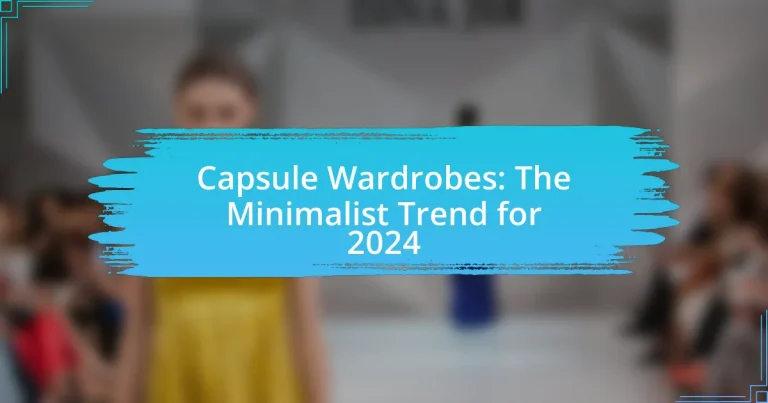Capsule wardrobes are curated collections of versatile clothing items, typically ranging from 20 to 40 pieces, designed to promote minimalism and sustainability in fashion. Originating in the 1970s, this concept emphasizes quality over quantity, allowing individuals to mix and match essential items for various outfits while reducing waste. The article explores the historical influences, key principles, and evolving definitions of capsule wardrobes, highlighting their growing popularity in 2024 due to increased consumer demand for sustainable fashion and the minimalist lifestyle. Additionally, it provides practical steps for creating and maintaining a capsule wardrobe, addressing common mistakes and the importance of intentionality in clothing choices.

What is a Capsule Wardrobe?
A capsule wardrobe is a curated collection of clothing items that are versatile and can be mixed and matched to create various outfits. This concept promotes minimalism by encouraging individuals to own fewer pieces, typically ranging from 20 to 40 items, which include essential clothing such as tops, bottoms, outerwear, and shoes. The idea originated in the 1970s and has gained popularity as a sustainable fashion choice, reducing waste and promoting mindful consumption.
How did the concept of a Capsule Wardrobe originate?
The concept of a Capsule Wardrobe originated in the 1970s, created by British designer Susie Faux. Faux introduced the idea to promote a collection of essential clothing items that can be mixed and matched, allowing for versatility and simplicity in fashion. This approach aimed to reduce clutter and encourage mindful consumption, aligning with minimalist principles. The term gained further popularity in the 1980s when American designer Donna Karan launched her “Seven Easy Pieces” collection, which exemplified the Capsule Wardrobe concept by offering a limited selection of interchangeable pieces.
What are the historical influences on Capsule Wardrobes?
Capsule wardrobes are historically influenced by the minimalist fashion movement of the 1970s, which emphasized simplicity and versatility in clothing. This concept was popularized by designer Susie Faux, who advocated for a limited selection of timeless pieces that could be mixed and matched. Additionally, the 1980s saw the rise of the “uniform” approach to dressing, where individuals curated their wardrobes to reflect personal style while minimizing excess. The environmental movement in the late 20th century further propelled the capsule wardrobe trend, as consumers began to prioritize sustainability and ethical fashion choices. These historical influences collectively shaped the modern understanding of capsule wardrobes as a means to achieve a functional, stylish, and sustainable approach to personal fashion.
How has the definition of Capsule Wardrobes evolved over time?
The definition of Capsule Wardrobes has evolved from a concept of a limited selection of essential clothing items to a more personalized and flexible approach that emphasizes sustainability and individual style. Initially popularized in the 1970s by designer Susie Faux, the idea focused on creating a small, curated collection of versatile pieces that could be mixed and matched. Over time, the definition expanded to include considerations of ethical fashion, with an emphasis on quality over quantity, reflecting a growing awareness of environmental impact. Recent trends highlight customization, allowing individuals to adapt their capsule wardrobes to personal preferences and lifestyle needs, thus making the concept more relevant in today’s fashion landscape.
What are the key principles of a Capsule Wardrobe?
The key principles of a Capsule Wardrobe include minimalism, versatility, and intentionality. Minimalism focuses on reducing the number of clothing items to a curated selection that reflects personal style. Versatility ensures that each piece can be mixed and matched to create multiple outfits, maximizing utility. Intentionality involves selecting high-quality, timeless pieces that align with one’s lifestyle and preferences. These principles promote a sustainable approach to fashion, reducing waste and encouraging mindful consumption.
How does minimalism play a role in Capsule Wardrobes?
Minimalism is fundamental to capsule wardrobes as it emphasizes simplicity and intentionality in clothing choices. Capsule wardrobes typically consist of a limited number of versatile pieces that can be mixed and matched, reducing clutter and decision fatigue. This approach aligns with minimalist principles by encouraging individuals to focus on quality over quantity, leading to a more sustainable and efficient wardrobe. Studies show that adopting a minimalist lifestyle can enhance mental clarity and reduce stress, which is reflected in the streamlined nature of capsule wardrobes.
What are the essential items typically included in a Capsule Wardrobe?
A capsule wardrobe typically includes essential items such as a classic white shirt, a tailored blazer, a pair of well-fitting jeans, a little black dress, versatile shoes like ankle boots, and a neutral-colored coat. These items are chosen for their ability to mix and match, providing a variety of outfits while minimizing clutter. The concept of a capsule wardrobe emphasizes quality over quantity, allowing individuals to create a cohesive style with fewer pieces. This approach is supported by the minimalist trend, which advocates for simplicity and intentionality in fashion choices.

Why is the Capsule Wardrobe Trend Gaining Popularity in 2024?
The Capsule Wardrobe trend is gaining popularity in 2024 due to increasing consumer demand for sustainability and minimalism in fashion. As individuals become more environmentally conscious, they seek to reduce waste and consumption, aligning with the principles of a capsule wardrobe, which emphasizes quality over quantity. Additionally, the rise of remote work has led to a shift in lifestyle, where versatile and functional clothing is prioritized. According to a survey by McKinsey & Company, 67% of consumers are willing to pay more for sustainable brands, highlighting a significant market shift towards eco-friendly fashion choices.
What societal factors are driving the minimalist trend?
The minimalist trend is primarily driven by societal factors such as consumerism backlash, environmental awareness, and the pursuit of mental well-being. The increasing dissatisfaction with material excess has led individuals to seek simplicity and intentional living, as evidenced by a 2021 survey indicating that 78% of respondents felt overwhelmed by their possessions. Additionally, the growing concern for sustainability has prompted many to adopt minimalism as a means to reduce waste and promote eco-friendly practices. This shift is further supported by research from the Journal of Consumer Research, which highlights that minimalism can enhance psychological well-being by reducing stress and fostering a sense of clarity.
How does sustainability influence the popularity of Capsule Wardrobes?
Sustainability significantly enhances the popularity of capsule wardrobes by promoting eco-friendly fashion choices. As consumers become increasingly aware of the environmental impact of fast fashion, they seek alternatives that reduce waste and encourage mindful consumption. Capsule wardrobes, which consist of a limited number of versatile clothing pieces, align with sustainable practices by minimizing overproduction and encouraging the use of high-quality, durable items. This shift is supported by research indicating that 60% of consumers prioritize sustainability in their purchasing decisions, reflecting a growing trend towards ethical fashion.
What role does consumerism play in the shift towards minimalism?
Consumerism drives the shift towards minimalism by highlighting the excess and unsustainability of overconsumption. As individuals become increasingly aware of the environmental and psychological impacts of consumer culture, many seek to simplify their lives through minimalism. Research indicates that the average American home contains over 300,000 items, leading to clutter and stress, which minimalism directly addresses by promoting fewer possessions and intentional living. This awareness has led to a growing trend in capsule wardrobes, where individuals curate a limited selection of versatile clothing, reflecting a conscious choice to prioritize quality over quantity.
How does a Capsule Wardrobe simplify daily life?
A capsule wardrobe simplifies daily life by reducing decision fatigue and streamlining outfit choices. With a limited selection of versatile clothing items, individuals can quickly mix and match outfits, saving time during the morning routine. Research indicates that simplifying choices can enhance productivity and decrease stress, as seen in studies on decision-making psychology. By focusing on quality over quantity, a capsule wardrobe also encourages mindful consumption, leading to a more organized and efficient lifestyle.
What are the time-saving benefits of adopting a Capsule Wardrobe?
Adopting a Capsule Wardrobe significantly reduces the time spent on outfit selection. With a limited number of versatile pieces, individuals can quickly mix and match clothing, leading to faster decision-making in daily dressing routines. Research indicates that people spend an average of 17 minutes each day deciding what to wear; a Capsule Wardrobe can cut this time by up to 50%, allowing for more efficient mornings and less stress. This streamlined approach not only saves time but also simplifies shopping and laundry processes, as fewer items require maintenance and organization.
How can a Capsule Wardrobe reduce decision fatigue?
A capsule wardrobe can reduce decision fatigue by limiting clothing choices to a curated selection of versatile pieces. This streamlined approach minimizes the number of daily outfit decisions, allowing individuals to focus on more important tasks. Research indicates that fewer choices can lead to increased satisfaction and reduced stress, as demonstrated in a study published in the Journal of Consumer Research, which found that too many options can overwhelm decision-making processes. By simplifying wardrobe options, a capsule wardrobe effectively alleviates the mental burden associated with daily outfit selection.

How to Create Your Own Capsule Wardrobe for 2024?
To create your own capsule wardrobe for 2024, start by selecting a limited number of versatile clothing pieces that can be mixed and matched. Aim for around 30 to 40 items, including tops, bottoms, outerwear, and shoes, focusing on neutral colors and classic styles that suit your lifestyle. Research indicates that a well-curated capsule wardrobe can reduce decision fatigue and enhance personal style, as seen in studies on minimalist fashion trends. By prioritizing quality over quantity, you ensure longevity and sustainability in your wardrobe choices.
What steps should you follow to build a Capsule Wardrobe?
To build a Capsule Wardrobe, start by defining your personal style and identifying essential pieces that reflect it. Next, declutter your existing wardrobe by removing items that do not fit, are not worn, or do not align with your style. Afterward, select a limited number of versatile clothing items, typically around 30 to 40 pieces, that can be mixed and matched for various occasions. Focus on quality over quantity, ensuring that each item is durable and fits well. Finally, regularly assess and update your Capsule Wardrobe seasonally to adapt to changing trends and personal preferences. This structured approach promotes a minimalist lifestyle while maximizing outfit options.
How do you assess your current wardrobe for a Capsule approach?
To assess your current wardrobe for a Capsule approach, begin by evaluating each item based on versatility, quality, and personal style. This involves categorizing clothing into essential pieces that can be mixed and matched, ensuring that each item serves multiple purposes. Research indicates that a well-curated capsule wardrobe typically consists of 30 to 40 items, which allows for a streamlined selection that minimizes decision fatigue and maximizes outfit potential. By focusing on timeless pieces that align with your lifestyle, you can create a functional and cohesive wardrobe that reflects your individual aesthetic while adhering to minimalist principles.
What criteria should you use to select versatile pieces?
To select versatile pieces, prioritize items that can be styled in multiple ways, fit various occasions, and coordinate with a wide range of other clothing. Versatile pieces should be made from high-quality, durable materials to ensure longevity and withstand frequent wear. Additionally, neutral colors and classic silhouettes enhance adaptability, allowing for seamless integration into different outfits. Research indicates that a well-curated wardrobe with versatile items can reduce decision fatigue and increase outfit options, supporting the minimalist trend of capsule wardrobes in 2024.
What common mistakes should you avoid when creating a Capsule Wardrobe?
When creating a Capsule Wardrobe, common mistakes to avoid include not defining a clear personal style, which can lead to purchasing items that do not align with one’s preferences. Additionally, failing to consider versatility in clothing choices can result in a lack of outfit combinations. Overlooking the importance of quality over quantity often leads to acquiring low-quality pieces that do not last, while neglecting to assess the current wardrobe can cause duplication of items. Lastly, setting an unrealistic number of pieces may create unnecessary pressure, making it difficult to maintain the Capsule Wardrobe effectively.
How can overcomplicating your wardrobe hinder the Capsule concept?
Overcomplicating your wardrobe hinders the Capsule concept by contradicting its core principle of simplicity and intentionality. The Capsule wardrobe is designed to consist of a limited number of versatile pieces that can be mixed and matched, promoting ease of decision-making and reducing clutter. When individuals add excessive items or overly complex styles, they dilute the effectiveness of this minimalist approach, leading to decision fatigue and a lack of clarity in personal style. Research indicates that simplifying choices can enhance satisfaction and reduce stress, which is fundamentally what the Capsule concept aims to achieve.
What pitfalls should you be aware of when choosing colors and styles?
When choosing colors and styles for a capsule wardrobe, be aware of the pitfalls of overcomplicating color palettes and neglecting personal style preferences. Overcomplicating can lead to a disjointed wardrobe that lacks cohesion, making it difficult to mix and match items effectively. Research indicates that a limited color palette, typically consisting of three to five colors, enhances versatility and ease of outfit creation. Additionally, ignoring personal style can result in a wardrobe that feels unrepresentative and unsatisfying, as individuals may struggle to express their identity through clothing. Therefore, maintaining a balance between simplicity and personal expression is crucial for a successful capsule wardrobe.
What are some practical tips for maintaining a Capsule Wardrobe?
To maintain a Capsule Wardrobe effectively, regularly assess and curate your clothing collection by removing items that no longer fit your style or needs. This practice ensures that your wardrobe remains functional and aligned with your lifestyle. Additionally, focus on investing in high-quality, versatile pieces that can be mixed and matched, which enhances the longevity and adaptability of your wardrobe. Research indicates that a well-maintained Capsule Wardrobe can reduce decision fatigue and promote sustainable fashion choices, as it encourages mindful consumption and reduces clutter.















